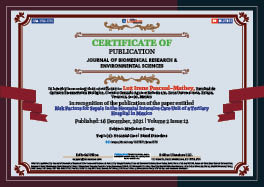Ilse Lizeth Villegas-Velasquez, Luz Irene Pascual-Mathey*, Olga Lidia Valenzuela-Limon, Patricia Elisa Molina-Prior, Jose Locia-Espinoza, Ezri Cruz Perez and Magda Olivia Perez-Vasquez
Volume2-Issue12
Dates: Received: 2021-11-29 | Accepted: 2021-12-14 | Published: 2021-12-16
Pages: 1183-1186
Abstract
Neonatal Sepsis (NS) is a systemic infection caused by bacteria, fungi, or viruses during the first month of life. Although various studies have identified the factors associated with NS, it is a public health problem due to its high morbidity and mortality. The study aimed to identify the risk factors associated with neonatal sepsis in the Neonatal Intensive Care Unit (NICU) of a tertiary hospital in Mexico. A case-control study was carried out using records of neonates (with sepsis 39 and without sepsis 39) from January to December 2017. The risk factors studied were the sociodemographic and clinical characteristics of the mother and clinics of the neonate. The data were analyzed using the Chi2 test, Fisher's exact test, Student's t-test, and the Odds Ratio (OR). The risk factors associated with NS were gestational age (OR 0.77, CI 95% = 0.64-0.91, p = 0.004), newborn weight (OR 0.45, CI95% = 0.23-0.86, p = 0.017) and days of hospital stay (OR 1.06, CI95% = 1.02-1.10, p = 0.0014). The mother's sociodemographic and clinical factors were not associated with NS. Risk factors associated with NS were gestational age, newborn weight, and days of hospital stay.
FullText HTML
FullText PDF
DOI: 10.37871/jbres1370
Certificate of Publication

Copyright
© 2021 Villegas-Velasquez IL, et al. Distributed under Creative Commons CC-BY 4.0
How to cite this article
Villegas-Velásquez IL, Pascual-Mathey LI, Valenzuela-Limón OL, Molina-Prior PE, Locia-Espinoza J, Pérez EC, Pérez-Vásquez MO. Risk Factors for Sepsis in the Neonatal Intensive Care Unit of a Tertiary Hospital in Mexico. J Biomed Res Environ Sci. 2021 Dec 16; 2(12): 1183-1186. doi: 10.37871/jbres1370, Article ID: JBRES1370, Available at: https://www.jelsciences.com/articles/jbres1370.pdf
Subject area(s)
References
- Morad EA, Rabie RA, Almalky MA, Gebriel MG. Evaluation of Procalcitonin, C-Reactive Protein, and Interleukin-6 as Early Markers for Diagnosis of Neonatal Sepsis. Int J Microbiol. 2020 Oct 1;2020:8889086. doi: 10.1155/2020/8889086. PMID: 33061986; PMCID: PMC7547329.
- Anaya-Prado R, Valero-Padilla C, Sarralde-Delgado A, Sánchez-González JM, Montes-Velázquez L, Gil-Villareal F. Sepsis neonatal temprana y factores asociados. Rev Med Inst Mex Seguro Soc. 2017;55(3):317-323.
- Hernandez IL, O hara LG, Arita IB, Nuñéz AJ, Fúnez EC. Factores asociados a sepsis neonatal temprana en recién nacidos del Hospital San Marcos, Ocotepeque. Rev Cient Esc Univ Cienc Salud. 2017;4(2):37-43.
- LekiĆ E, BoboviĆ S, VukiceviĆ J, NešoviĆ M, Dragaš L. Early-onset neonatal sepsis and risk factors in the preterm infants. Perinatal Journal. 2019;27(3):143-9.
- Mogollón C, Bautista E, Hernández-Arriaga G, Bueso-Pineda L, Tovani-Palone M, Mejia C. Factors associated with early-onset neonatal sepsisin children of Peruvian Military Personnel. Electron J Gen Med. 2019;16(5):em156. doi: 10.29333/ejgm/114059
- Sánchez-Garduño J. Procalcitonina y Sepsis Neonatal: Aspectos Clínicos y Del Laboratorio. Revista Latinoamericana de Patología Clínica. 2016;63(3):148-154.
- Adib M, Bakhshiani Z, Navaei F, Saheb Fosoul F, Fouladi S, Kazemzadeh H. Procalcitonin: a reliable marker for the diagnosis of neonatal sepsis. Iran J Basic Med Sci. 2012 Mar;15(2):777-82. PMID: 23493845; PMCID: PMC3586883.
- Carrillo ER, Pérez CA. Procalcitonina como marcador de procesos infecciosos en cirugía: Conceptos actuales Cir gen. 2013;35(1):49-55.
- Londoño-Agudelo JM, Jaimes-Barragán FA, Hoyos-Vanegas NA, Niño-Pulido CD. Uso de biomarcadores en el diagnóstico y el tratamiento de la sepsis. Iatreia. 2013;26(4):457-466.
- Tunç T, Polat A, Özdemir R, Kiliçaslan B, Can E, Çelik HT, Arsan S, Kader Ş, Erol S, Uslu S, Özdemir ÖMA; Turkish Neonatal Sepsis Group, Özcan B, Hanta D, Dilli D, Narter F, Gültekin N, Güzoğlu N, Aydemir Ö. Assessment of novel biomarkers: sTREM-1, pentraxin-3 and pro-adrenomedullin in the early diagnosis of neonatal early onset sepsis. J Neonatal Perinatal Med. 2020;13(1):47-54. doi: 10.3233/NPM-180131. PMID: 31594258.
- Alvarado-Gamarra G, Alcalá-Marcos KM, Abarca-Alfaro DM y Bao-Castro V. Características microbiológicas y terapéuticas de la sepsis neonatal confirmada en un hospital de Lima, Peru. Rev Peru Med Exp Salud Publica. 2016;33(1):74-82. doi: 10.17843/rpmesp.2016.331.2010.
- Leal YA, Álvarez-Nemegyei J, Velázquez JR, Rosado-Quiab U, Diego-Rodríguez N, Paz-Baeza E, Dávila-Velázquez J. Risk factors and prognosis for neonatal sepsis in southeastern Mexico: analysis of a four-year historic cohort follow-up. BMC Pregnancy Childbirth. 2012 Jun 12;12:48. doi: 10.1186/1471-2393-12-48. PMID: 22691696; PMCID: PMC3437209.
- Arias-Arellano S, Cáceres-Aucatoma F, Geyson D, Segarra-Galarza K. Factores de riesgo asociados a sepsis neonatal tardía. Rev Med Inst Mex Seguro Soc. 2019;57(4):226-31.
- Ahmed M, Yasrab M, Khushdil A, Qamar K, Ahmed Z. Neonatal sepsis in a tertiary care hospital: bacteriological profile and its antibicrobial sensitivity. PAFMJ. 2018;68(6):1654-1658.






























































